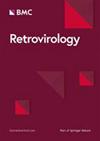通过反转录转座子将SARS-CoV-2 RNA整合到受感染的人类细胞中:一个不太可能的假设和旧的病毒关系
IF 3.9
3区 医学
Q3 VIROLOGY
引用次数: 3
摘要
Zhang等人(Proc Natl Acad Sci 118: e2105968118,2021)最近报道了SARS-CoV-2 RNA可以通过L1逆转录转座子机制逆转录并整合到人类细胞的DNA中。这一现象可能导致病毒序列在患者体内持续存在,并可能解释SARS-CoV-2感染患者的pcr阳性持续时间长,即使在活跃的病毒复制阶段结束后很长时间。本评论严格审查了关于这一主题的现有数据,并结合对其他外源性病毒和祖传内源性逆转录病毒成分的发现进行了讨论。本文章由计算机程序翻译,如有差异,请以英文原文为准。
Integration of SARS-CoV-2 RNA in infected human cells by retrotransposons: an unlikely hypothesis and old viral relationships.
Zhang et al. (Proc Natl Acad Sci 118:e2105968118, 2021) recently reported that SARS-CoV-2 RNA can be retrotranscribed and integrated into the DNA of human cells by the L1 retrotransposon machinery. This phenomenon could cause persistence of viral sequences in patients and may explain the prolonged PCR-positivity of SARS-CoV-2 infected patients, even long after the phase of active virus replication has ended. This commentary does critically review the available data on this topic and discusses them in the context of findings made for other exogenous viruses and ancestral endogenous retroviral elements.
求助全文
通过发布文献求助,成功后即可免费获取论文全文。
去求助
来源期刊

Retrovirology
医学-病毒学
CiteScore
5.80
自引率
3.00%
发文量
24
审稿时长
>0 weeks
期刊介绍:
Retrovirology is an open access, online journal that publishes stringently peer-reviewed, high-impact articles on host-pathogen interactions, fundamental mechanisms of replication, immune defenses, animal models, and clinical science relating to retroviruses. Retroviruses are pleiotropically found in animals. Well-described examples include avian, murine and primate retroviruses.
Two human retroviruses are especially important pathogens. These are the human immunodeficiency virus, HIV, and the human T-cell leukemia virus, HTLV. HIV causes AIDS while HTLV-1 is the etiological agent for adult T-cell leukemia and HTLV-1-associated myelopathy/tropical spastic paraparesis. Retrovirology aims to cover comprehensively all aspects of human and animal retrovirus research.
 求助内容:
求助内容: 应助结果提醒方式:
应助结果提醒方式:


